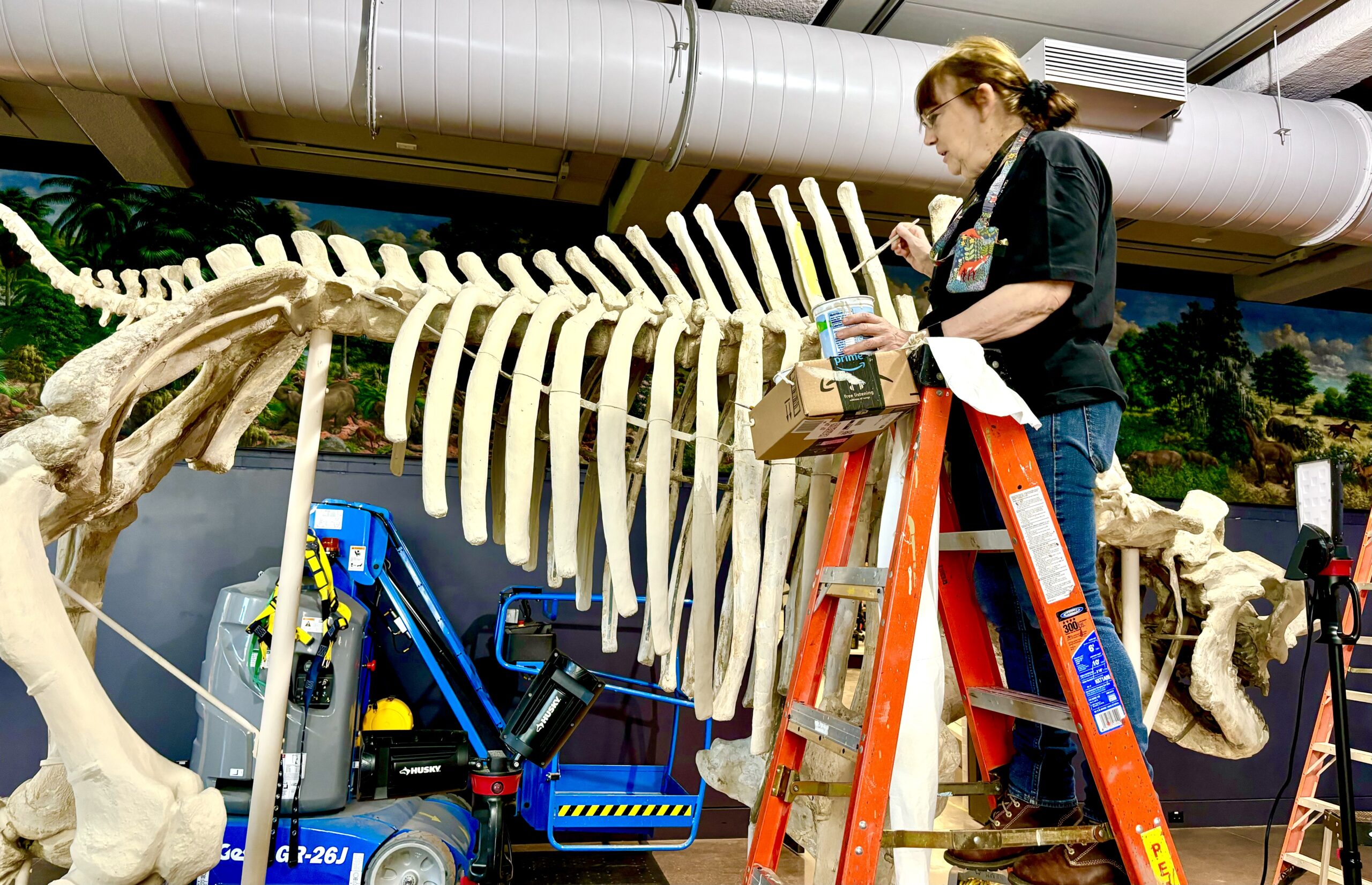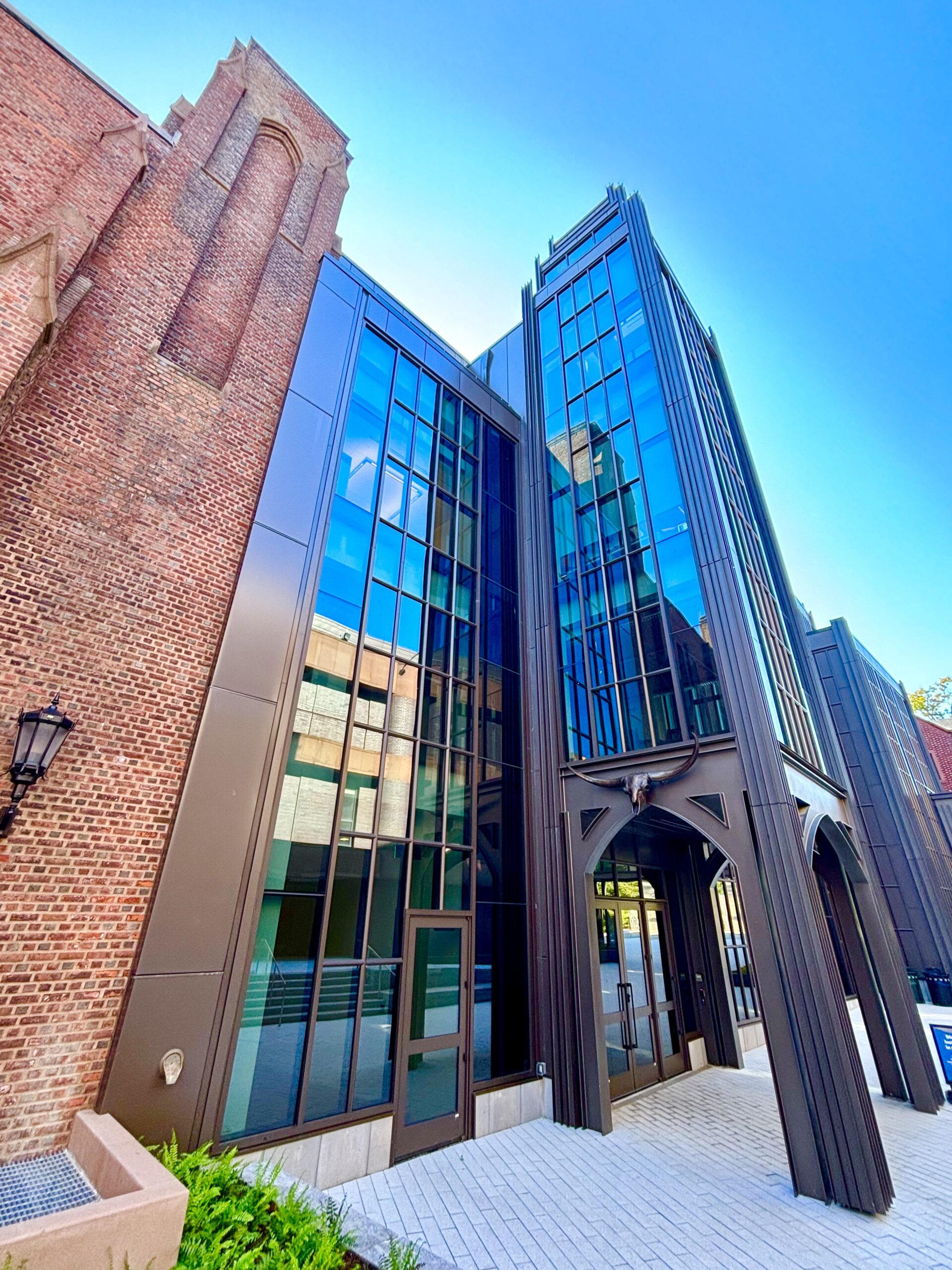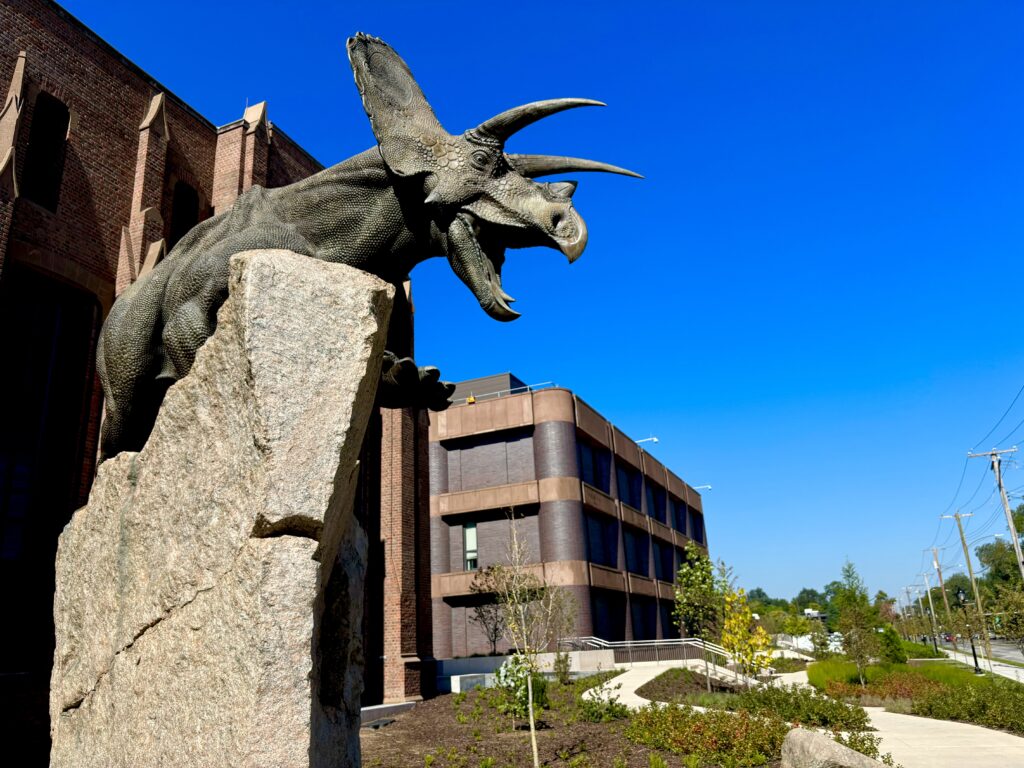Written and photographed By FRANK RIZZO
LOOK UP! Flying high in the Peabody Museum’s new central gallery, just below its glass ceiling, is a fossil of an Archelon, a huge sea turtle. It is chased by an even more extraordinary fossil, that of a tylosaurus, a 40-foot-long marine reptile that resembles a giant alligator, its jaws open and ready for the kill.
It’s one of the many new dynamic displays which will be showcased when the expanded and renovated Peabody Museum opens in early 2024. There will be 50% more exhibition space depicting the first couple of 100 million years of life on Earth in its new 171,500-square-foot complex. There will also be additional rooms for classwork and research, areas for study, a new gift shop, and spaces indoors and outdoors for special events or just for hanging out.

Launched with a $160 million gift in 2018 from Edward P. Bass (’68), the four-year construction project is now poised to be one of the region’s major attractions, now renamed Yale Peabody Museum from its earlier wordy monicker: The Peabody Museum of Natural History at Yale University.
Founded in 1866 by philanthropist George Peabody at the behest of his nephew Othniel Charles Marsh, an early paleontologist, it’s one of the world’s oldest and largest university museums of its kind.
It is home to over 14 million objects and specimens representing more than 4 billion years of the planet’s natural and human history. With the new expansion, the public will get to see between 5,000 to 6,000 items from its many collections in its renovated and new gallery spaces, the largest addition of exhibition area in its re-envisioned second floor, previously used for administration offices. Much of the storage and conservation work has been transferred to Yale’s West Campus in Orange.
Thanks to the lead gift, the Peabody will join the Yale University Art Gallery, the Yale Center for British Art, and the Beinecke Rare Book and Manuscript Library in offering free public admission. (Previously entry to the museum was $13 for adults, $9 for seniors and $6 for children.)
“We anticipate doubling our attendance after reopening,” said Christopher Renton, associate director of marketing and communications. “That would mean 200,000 to 300,000 people.” Next year will also mark a double museum reopening in New Haven; The Yale Center for British Art, which closed in 2023 for renovations, will also open its doors again.

“Having the opportunity to be a part of the next iteration of the Peabody is a huge privilege,” said David Skelly, the museum’s director since 2014. He was born and raised in Norwalk, and fondly remembers coming to the museum as a child.
Still roaring outside of the newly landscaped complex is the Peabody’s full-scale reproduction of a 21-foot-tall torosaurus perched on a 13-foot granite pedestal.
But now instead of the towering French Gothic brick and dark brown sandstone entry way, visitors will approach the building on Sachem Street. The new all-accessible entrance will allow buses to drop off students to gather and then enter into an expanded lobby area without impeding other visitors. There’s also a new freight elevator to easily move large tour groups to classrooms on another level before they begin their field trip through the flowing pathways of the new museum.
Since admission is free, the former ticket center will now feature a state-of-the-art “welcome kiosk” supplying information to visitors. Even here there are playful hints of what’s to come inside, with a mother pterosaur climbing up one of the lobby’s arched walls, its more massive father pterosaurs on another wall, posed as if they are using the interior as a rookery.
The new gift shop is also nearby. There will be “some food pop-ups” with outdoor tables and seating, much like that outside the Yale University Art Gallery, but there is no museum café, yet.
Visitors will go directly into the new light-filled, multi-storied central gallery, formerly a disused courtyard flanked by two buildings. Designed by Centerbrook Architects & Planners, visitors will first take in the overhead chase of the Archelon (one of the largest turtles that ever lived) and a tylosaurus (an epic aquatic predator), both suspended from the beamed ceiling and bathed in natural light.
Moving from the central gallery into the great dinosaur hall, visitors will confront an old fossilized friend: the familiar 75-foot brontosaurus, a main attraction at the Peabody since its arrival in 1879; it has been given more breathing room where visitors can take a better view. Its pose and posture have been updated to reflect the latest paleontological research. The newly reconditioned and remounted fossil—with 30 feet of additional vertebrae—is now poised in an active stance, as if running. Visitors will have better sight lines and will even be able to walk beneath its tail and neck.
Each brontosaurus bone, said Skelly, is now attached to individual felt-covered armatures so scholars can study the femurs by having them removed individually for closer inspection.
Also featured are the more animated stegosaurus, triceratops, ancient mammals and mastodons. And yes, remaining in place is the iconic 110×16-foot “The Age of Reptiles” fresco secco painting by Rudolph F. Zallinger, which was created in 1947.
The museum will also feature five new classrooms embedded in the galleries on all floors, which will allow students proximity to the museum’s vast collections. “Students can view people in work rooms working with fossils,” said Renton.
There’s also a new “study gallery,” a space where faculty can request objects to be put on display for their students. Another student-driven space will be the Student Exhibition Gallery where students can present their own Peabody-centric exhibitions.
There will be permanent exhibits in a human culture gallery, which features some of the world’s oldest cookbooks and a tablet of epic poetry by the world’s first named author who was a woman, more than 4,000 years ago.
The second floor will also allow temporary exhibitions highlighting many fields. The first, in collaboration with Yale’s neuroscience center—the Wu Tsai Institute—will center on the brain.
Skelly pointed out that for decades the Peabody has had a history of science and technology division that centered on paleontology, ecology, geology and anthropology but it never had a permanent gallery for it. “Now it will,” he said, adding that the fields off chemistry, physics, astronomy and molecular biology will also be included in its storytelling.
There are also new spaces for year-round outreach events, and a new outdoor courtyard area for community gatherings which will also feature a paleo-garden, showing living fossil plants. Outside on the north side, a new glass-encased walkway connects the museum to neighboring Kline Geology Lab. New temperature and humidity controls and state of the art security will protect the Peabody’s possessions.
Much of the museum’s collections not being exhibited or studied have been relocated to a newly renovated, 19,000-square-foot space in the Collections Study Center on West Campus in West Haven. (No tours of that facility are planned at the moment.)
When the Peabody officially opens, Skelly concluded, “there will be much more to see in more places. There’s a lot of cool stuff here.”
The museum is located at 170 Whitney Ave., New Haven, CT. There is a dedicated parking area within Yale Lot 22 just north of the museum on Whitney Avenue, across from Humphrey Street. Find out more information at (203) 432-3738 and peabodyevolved.yale.edu.







More Stories
Over 50, Underestimated: The Grandfluencers Redefining Age on Social Media
Wadsworth Atheneum Museum of Art: (Un)Settled Art Exhibition Moves Beyond Classic Landscapes
Building Resilient Businesses: Strategies for Success